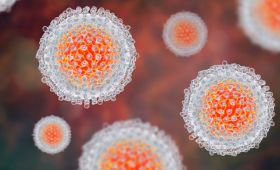New class of drugs effective against SARS-COV-2 and many RNA viruses

Researchers may have discovered a new class of front line drugs that can both prevent the spread of new viruses and limit their severity. In laboratory tests, the already available treatments showed promise in fighting a range of existing RNA viruses, including SARS-Cov-2 and other human coronaviruses.
Scientists have identified a new class of drugs with the potential to prevent and treat future viral outbreaks.
University of Alberta researchers successfully tested a group of 10 existing compounds against a number of viruses in the laboratory - including the SARS-CoV-2 coronavirus that causes COVID-19. If successful in future human clinical trials, these compounds could then become “first line drugs against emerging viruses”, including new coronavirus variants.
This means they could be given to people as a pill or nasal spray before or soon after they show symptoms of infection. A four- or five-day course would then potentially be enough to limit contagion and the disease’s severity, without significant side-effects. The Alberta group had previously studied how the HIV virus has evolved to stop the human body from triggering its immune system through activating a cellular signalling pathway called Wnt/β-catenin. This, they said, prevented the production of organelles called peroxisomes, which cause the body to produce interferon (IFN) – a key part of our immune response to viruses.
The team theorised that SARS-Cov-2 and other viruses have also evolved to activate the Wnt/β-catenin pathway– and that using drugs to block it would cause increased peroxisome formation and a “more robust” interferon response to viral infection.
Many drugs that target Wnt/β-catenin have already been developed with the aim of treating cancer, and the Alberta group started with 40 such compounds before selecting a group of 10 that showed particular promise.
In the laboratory, they treated a human bronchial Calu-3 cell line with both the Wnt/β-catenin inhibitors and the SARS-Cov-2 virus, finding that “All the compounds reduced viral titers (viral levels) by at least 80% and as much as 98%” when added before the virus. The drugs were also effective - reducing SARS-Cov-2 replication by 77-94% - when added to the cells 12 hours after the virus. In both experiments, they also reduced viral genomic RNA levels significantly.
These impressive findings were repeated when a different human cell line – featuring normal human bronchial epithelial (NHBE) lung cells – was treated with the same drugs. “Most of them reduced virus production and/or release from NHBE cells by 90% or more,” the group reported. “Moreover, two of the drugs KYA1797K and Pyrvinium, reduced viral titers to undetectable levels by plaque assay.”
The Canadian group also supported its peroxisome hypothesis by demonstrating significant increases – in some cases of more than 50% – in levels of the organelle in lung cell lines following treatment with all 10 Wnt/β-catenin inhibitors. In addition, adding the 10 drugs to cells treated with Sendai virus resulted in most of them increasing levels of type I and Type III interferon. Even more encouragingly, the results were replicated when the drugs were used in vivo on laboratory mice. Although pyrvinium could not be used because it was toxic to the animals, the drugs KYA1797K and E7449 reduced SARS-Cov-2 viral titres 23- and 36-fold respectively, as well as protecting peroxisome levels from the effects of the virus.
Finally, the group tested the inhibitors on four more viruses – the human coronaviruses HCOV-NL63 and HCOV-229E, Zika virus, and the Mayaro virus – in order to determine whether they possessed broad spectrum antiviral activity. Again, the results were very promising, as pyrvinium treatment reduced viral titres of NL63 and 229E by >100-fold and >10-fold, respectively, whilst KYA1797K reduced them to below the detectable threshold as well as proving potent against Zika and Mayaro.
“Together, our findings provide a strong rationale for further study of Wnt/β-catenin inhibitors as prophylactic or early-stage treatments for RNA virus infections,” the group wrote in the journal npj Viruses.
Three members of the team have a US patent pending on their approach, and the group is currently looking for a pharmaceutical partner to help it carry our human clinical trials. In the meantime, it is performing pre-clinical studies to identify the most promising drug and dose to proceed with. “Interferon does two things that result in the inability of an infected cell to produce more virus,” said principal investigator, Professor Tom Hobman.
“Interferon does two things that result in the inability of an infected cell to produce more virus,” said principal investigator, Professor Tom Hobman.
“It shuts down the infected cell, often resulting in cell death, and it also acts on the surrounding cells to prevent them from being infected.
“The beauty of this approach is that in the absence of viral infection, there's no interferon produced.
“We see these drugs potentially serving as first-line drugs against emerging viruses.”
|
Author Joe Lackey – Technical Specialist
Joe holds a PhD in Molecular Physiology from the University of Dundee, as part of which he worked in early drug discovery - investigating the role of the PI-3 kinase signalling pathway in tumour growth. He has worked as an LGC technical specialist for seven years, enabling him to explore his significant interests in personalised medicine, cancer biology, and the journey to the clinic.
|




